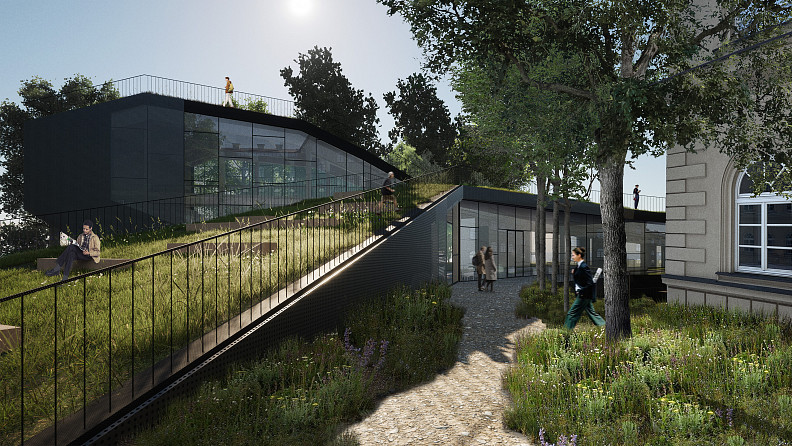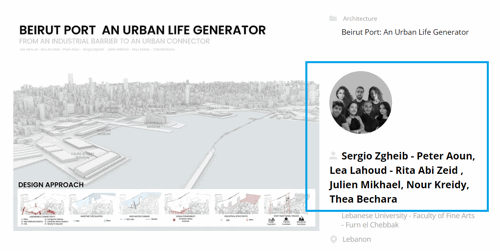Łobzów Courtyard

Project idea
A fusion of different qualities, ideas or things is something new that is created by joining them together.
This building is a fusion:
1.A fusion of the old and the new in the context of existing historic building.
2.A combination of the existing green space with an object that absorbs this greenery, strengthens it, and at the same time subtly penetrates it.
3.A connection that creates an outdoor space for the integration of the students - architecture, but also from the other departments.
4.A connection, which in the form of the object was emphasized by the hall uniting three forms diverging from it.
The goal of our project was to fit the construction harmoniously into the surroundings without interfering with the university's existing building. At the same time, we wanted to create fresh, innovative spaces dedicated to the students.
The area around the university has been characterised by a lot of greenery and trees, which we decided to preserve. We took advantage of the greenery's potential, which resulted in the camouflaging the designed building on the university grounds. We also decided to cover the roof with vegetation, creating a separate layer of the building's structure that also serves a functional purpose.
We aimed at maximising the use of this area, so we created open spaces from the -1 level to the roof, encouraging integration with the environment and interpersonal interactions
The architectural design named "Fusion" perfectly combines the form and the function. Three cubes harmoniously converge at a single point, creating common fused spaces. This subtle integration of form symbolizes unlimited space concurrently opening it up to the maximum, making it possible to create both ample and intimate spaces according to the requirements of function.
The landscaping creates a seamless connection between the 600 years old historic building and the newly designed one. The exterior stairs, descending to level -1, as well as the main entrances, were designed on the axis of the main entrance area of the old building. The pathways have been arranged for efficient, universal communication between the two departments.
The design assumption was to create an accessible, friendly space for students. The design literally comes out of the ground and reflects the land used for the development in the form of a green roof, winding between existing trees. The variable angle of the slope creates a harmonious transition between the terrain and the functional space on the upper levels. The space is equipped with seats that can be used for relaxation, integration and outdoor classes.
Project description
Level 0 was designed with the needs of students. An open form permeates the lobby, which is the heart and keystone, which gently separates the functions of the various sections. The varied space of the cafeteria, reading room and mezzanine, creates a friendly space for students to feel well in it, it answers the needs of the community. The mezzanine creates a friendly space to display exhibitions, but at the same time is an element that belongs to the multifunctional hall, creating an integration of level -1 and 0.
Level -1 has been shaped so that it can be a single, functionally independent zone. Efficient communication between the main multipurpose room, the modeling room, the cloakroom and the restrooms allows this level to be closed off for important events.
Technical information
The priority in the design of "Fusion" was not only the absence of spatial constraints, but also the maximum opening, allowing flexibility to create both spacious and intimate areas. This not only allows complete freedom, but also ensures functionality by allowing any division or creating smaller spaces depending on the needs.
The sliding glazing allows the space to be naturally enlarged by opening up and further integrating the interior with the outside environment.
All spaces have been designed with intentional multi-functionality and flexibility. Therefore, fixed vertical partitions have been reduced, and the building's floor plans are a fluid, open entity that integrates with the outside. We opted for the use of movable vertical elements, delineating spaces according to the current needs of the university. Premises can be quickly modified and separated in any way, thanks to the use of walls on wheels, curtains, modular furniture, folding doors/stage in the multipurpose room.
A distinctive form is the part of the building which is the reading room, which was inspired by a drawing of one of the model atrium layouts. It is an important element of the whole establishment, which has been emphasized by its shape and height. The space is ultimately a reading room with study desks, but can also serve as a drawing room.
The building features a green roof that absorbs up to 90% of rainwater, provides shade, and contributes to a cooler microclimate by releasing excess heat. Rainwater collected from the roof is directed into a dedicated tank via a pump system, enabling the reuse of water, for example, for irrigation or sanitary purposes. The building also incorporates low-emissivity glass (e-glass), which enhances thermal comfort by reducing heat transfer and supporting energy efficiency. To protect birds, the glass includes special bird-safe technology (FlySafe™ 3D PVB Safe+), which prevents collisions.
Natural lighting plays a key role in the building’s design, with carefully positioned openings that allow sunlight to reach interior spaces, reducing the need for artificial lighting. The rooftop garden, planted with greenery, improves insulation and air quality while also serving as a pleasant visual and ecological feature. The interior uses responsibly sourced construction materials, including FSC-certified structural wood, ensuring a low environmental impact. Additionally, the space is furnished with modular furniture from a Polish manufacturer (mdd), supporting local production and flexible interior arrangements.
Overall, the concept combines energy efficiency, sustainability, and human well-being, showcasing a holistic approach to eco-friendly architecture.









